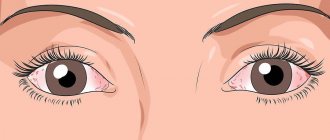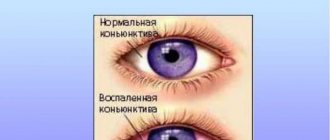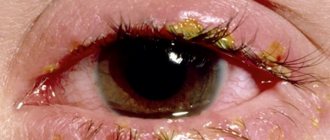Conjunctivitis is a common eye disease familiar to almost all of us. Children especially often suffer from this inflammation of the visual organs. Conjunctivitis can occur as an independent disease or develop against the background of viral infections: ARVI and influenza. Let's talk about the types of this eye pathology for colds and methods of treatment.
Conjunctivitis, depending on the reason for which it arose, is divided into three types:
- viral;
- allergic;
- bacterial.
Viral conjunctivitis is the most common of all types of this disease, which often develops as a complication of any viral disease. The causative agents of both the underlying disease and eye inflammation are usually adenoviruses. Let's tell you more about the types of conjunctivitis associated with colds and how to treat them.
What are adenoviruses
These are common pathogens of viral pathologies. Adenoviruses were first isolated in the 50s of the 20th century, and today 54 types of adenoviruses pathogenic for humans are known in medical practice, which are divided into 7 groups.
These microorganisms are very tenacious. They can remain active for up to 2 weeks on dirty surfaces, and die only when heated to 56 degrees, when treated with chloramine or heated with ultraviolet light. In addition, viruses are easily transmitted by airborne droplets and household contact, which is why diseases caused by them become epidemic. The main part of adenoviruses causes upper respiratory tract infections: acute respiratory viral infections, influenza, and are also often the cause of conjunctivitis, tonsillitis, otitis media and other ailments. Children under 6-7 years of age are most susceptible to adenoviruses. Their immunity is too weak and is not able to resist the virus that has entered the body too actively. If signs of illness are detected in a child—fever, cough, runny nose—urgent therapeutic measures must be taken. According to medical statistics, adenoviral infections in children under six years of age account for up to 30% of cases of all viral illnesses. In this case, conjunctivitis is a common complication against their background.
Here are some diseases that can cause eye inflammation:
- influenza, parainfluenza;
- ARVI is an acute respiratory viral infection (there are up to 200 types);
- nasopharyngitis;
- acute respiratory diseases, etc.
What symptoms accompany viral infections in adults and children?
Ailments of this type have characteristic signs that indicate a viral etiology. They usually begin with an increase in temperature, in some cases it reaches 39°C. They are also accompanied by the following manifestations:
- weakness and lethargy in the muscles;
- severe cough and runny nose, nasal congestion with copious discharge;
- sore throat, pain when swallowing;
- swelling of the tonsils with the appearance of a whitish purulent coating on them;
- lacrimation, swelling and hyperemia of the conjunctiva, pain in the eyes;
- loss of appetite;
- enlarged parotid and cervical lymph nodes.
In terms of external signs, ARVI and influenza are quite similar, but they have differences. Thus, with acute respiratory inflammation, the symptoms are quite pronounced. The eyes become very red and itchy, and there is a feeling of “sand” in them. The second distinctive feature of colds is their rapid development: the period of acute intoxication usually lasts 1-2 days, while with the flu, negative symptoms can last up to 7 days or longer. Another characteristic sign of ARVI is the duration and course of the fever. The temperature can rise to 39°C on the first day, but it does not last long and soon declines. With influenza, high fever and fever may persist for a week, despite therapeutic measures taken. From the first day of illness, when adenovirus infection occurs, conjunctivitis and a severe runny nose become its companions. Abundant transparent discharge appears from the nose, which can soon take on a mucopurulent character. It becomes difficult to breathe, the nose becomes blocked, and the patient is forced to breathe through the mouth. The tonsils and pharynx swell and turn red, a strong cough develops, first dry, and after 3-4 days expectorating with sputum.
Traditional medicine
Traditional methods cannot provide complete treatment, but it can be supplemented. The following remedies are most effective:
- Aloe will help overcome cough and conjunctivitis. A mixture of peeled, crushed leaves of the plant with honey (1:1) is taken in a teaspoon 3-4 times a day. It softens the throat and relieves inflammation. Eyes are wiped with aloe juice several times a day. As a result, the itching subsides and the amount of discharge decreases.
- Essential oils relieve the condition of an adult or child with a runny nose and conjunctivitis. A couple of drops are added to the water for the aroma lamp, or an open bottle of oil is left in the room. Eucalyptus, mint, and tea tree are especially effective.
- Cornflower, chamomile, oak bark, and birch buds have disinfectant properties. To prepare a decoction, you need 0.25 cups of boiling water per tablespoon of dry raw materials. The finished infusion is used to wash the eyes for a maximum of 24 hours, then it is replaced with fresh one.
Conjunctivitis is a “companion” of adenoviral infection
This is what ophthalmologists themselves call this complication of ARVI and influenza. With the development of these diseases in children and adults, concomitant inflammation of the eyes almost always begins. The conjunctiva turns red and swells, severe itching and burning begins, lacrimation begins, there is a sensation of a foreign body in the eyes, irritation from bright light, some types of viral conjunctivitis are characterized by clouding of the cornea and decreased clarity of vision. In the case of a prolonged course of a cold or flu, a bacterial infection may accompany it, and then purulent discharge from the eyes will be added to the symptoms of viral conjunctivitis.
In such a situation, treatment will take a longer period. Doctors constantly remind: if any unpleasant sensations appear in the organs of vision, you need to visit a specialist to find out the cause, and not look for advice on forums or self-medicate. These are the types of conjunctivitis as complications that can occur against the background of adenoviral infections.
Causes
Conjunctivitis occurs as a result of various provoking factors. The reasons for the development of a runny nose and conjunctivitis are.
Viral and cold infections: influenza, acute viral diseases, colds. When the infection enters the respiratory system, an inflammatory process and cough occur. Through the nasolacrimal ducts, inflammation spreads to the mucous membrane of the eyeball. Allergic reaction: pollen from flowering plants, mold, pet hair, chemical compounds, feathers, food. The action of a certain allergen is the main reason for the manifestation of the body's protective function. It is detected in the form of an allergic reaction, which is accompanied by the appearance of a runny nose and conjunctivitis. Lack of personal hygiene: contact of mucous membranes with dirty hands, mechanical damage, improper use of lenses for vision correction. When an infection enters the mucous membrane of the eyeball, active lacrimation begins. Bacteria pass through the nasolacrimal ducts into the nasopharynx and lead to the development of rhinitis. Prolonged exposure to air at sub-zero temperatures.
Hypothermia of the body leads to inhibition of the body's protective functions. The result is a runny nose, cough , and conjunctivitis.
Catarrhal superficial conjunctivitis
The catarrhal form of eye inflammation must be treated in a timely manner, since its consequences pose a danger to vision. The disease is characterized by copious discharge from the eyes, from which the eyelashes stick together, and there is also noticeable swelling of the eyelids and redness of the mucous membrane. Here are some manifestations that may indicate that the patient has developed catarrhal purulent conjunctivitis:
- burning, itching in the eyes;
- increased sensitivity to daylight or artificial lighting;
- copious discharge in the form of cloudy mucus with flakes;
- corneal ulceration;
- hyperemia and swelling of the mucous membrane and surrounding tissues;
- blepharospasm (incomplete closure of the eyelids).
For this type of conjunctivitis during ARVI, antiviral drugs are prescribed to help eliminate symptoms. In addition, the disease itself, against which it developed, is also treated. With timely consultation with a doctor, compliance with the course of therapy and hygiene rules, catarrhal conjunctivitis is successfully cured in 2 weeks; in the chronic form, the process can last for 30-40 days. However, in some cases, when the start of treatment is delayed or the patient does not comply with the doctor’s instructions, negative consequences may occur:
- blepharitis (bilateral inflammation of the eyelids);
- keratitis, dry eye syndrome;
- a large accumulation of pus in the lower part of the organ of vision;
- inflammation of the middle ear;
- deformation of the eyelids.
Catarrhal conjunctivitis is a dangerous eye disease that requires responsible and timely treatment. An individual approach is required for each specific case. The wrong medicine can make the situation worse. The signs of catarrhal conjunctivitis against the background of ARVI in a child are identical to the general symptoms in adults.
Prevention
Preventing pathology is much easier than treating it, so you should follow simple rules that even a child can understand.
To avoid diseases of the nasopharynx and eyes, it is recommended to maintain personal hygiene, strengthen the immune system, toughen up, engage in feasible sports, eat right and get enough sleep. During influenza epidemics, you should avoid crowded places, carry out wet cleaning of the room, and take vitamin C preparations. It is necessary to promptly treat all foci of infections in the nasopharynx, and keep chronic forms of ailments in remission by regularly checking with a doctor. During spring flowering, you should use antihistamines (Loratadine, Cetrin, Claritin).
Membranous conjunctivitis
This type of disease is less common than others and has some distinctive features. Grayish-white films form on the mucous membrane, which should be removed with a cotton swab. Usually they are separated without problems, however, if they are already tightly fused to the conjunctiva, then when removed, the surface may become damaged and begin to bleed. After a course of treatment and elimination of the symptoms of conjunctivitis, scars sometimes remain on the mucous membrane. It happens that this disease is confused with diphtheria.
Epidemic keratoconjunctivitis
Epidemic keratoconjunctivitis is a complication of adenoviral or bacterial infection. Patients first complain of a sensation of a foreign body in one eye, and then these manifestations are accompanied by swelling of the eyelids, redness of the mucous membrane of the eyelids, profuse lacrimation, itching, photophobia, and deterioration in clarity of vision. After a few days, signs of epidemic keratoconjunctivitis, as a rule, spread to the second eye (in 70% of cases).
A distinctive sign of keratoconjunctivitis, which represents the main danger in advanced cases, is clouding of the corneal tissue. This occurs due to the accumulation of infiltrates in the superficial, conjunctival layers. At the same time, these formations can dissolve over a fairly long period, sometimes up to a year or more. At this time, visual acuity noticeably decreases, so that sometimes a person is forced to temporarily leave their usual activities.
By contacting a specialist in a timely manner and starting treatment, such negative consequences for the eyes can be avoided. In general, the remaining symptoms of keratoconjunctivitis disappear in about a month with proper therapy.
Conjunctivitis due to influenza
Another acute upper respiratory tract disease caused by the influenza virus. It also belongs to the ARVI group, often spreading in the form of epidemics and pandemics. The influenza virus has the ability to constantly mutate. Every year new serotypes appear. Currently, about 2000 varieties of this disease have been identified. Signs of influenza are often similar to those of acute respiratory viral infections: cough, fever, mucus from the nose. However, there is still a difference. It is the correctly identified symptoms of influenza infection that will help cure it faster.
- With ARVI, the temperature rarely rises above 38°C and usually goes away within 2 days, but with the flu it can reach 39-40°C and last up to a week, especially in children.
- Lethargy, weakness and muscle aches, fever, profuse sweating, eye pain, headache, aversion to daylight or artificial light.
- Swelling of the nasal cavity. With ARVI, a runny nose lasts throughout the entire period of the disease, accompanied by copious nasal discharge, and with influenza there is usually only slight congestion in the sinuses.
- The mucous membranes become inflamed in different ways during colds and flu: with ARVI, the throat and nose turn red, with flu - the back wall of the pharynx and the soft palate.
- A severe cough, first dry, then with sputum, is characteristic of both diseases.
- Inflammation and redness of the mucous membrane of the eyes is more typical as a complication of ARVI, however, this is also a common occurrence with influenza. A runny nose and cough, along with conjunctivitis, are three main signs of viral diseases.
Viral conjunctivitis with influenza is a rather dangerous condition, as complications may arise in the form of optic neuritis or keratitis. The inflammatory process in the eyes can develop within a few days after recovery.
Treatment of viral conjunctivitis in ARVI and influenza
drops and ointments with interferon. When treating any type of conjunctivitis - viral, bacterial, allergic - it is necessary to wash the eyes before administering medications. To do this, you can use weak solutions of various products: boric acid, furatsilin, or special products - for example, “Blefarolion” from the Russian.
Procedures should be carried out with pre-washed hands to avoid introducing dirt. You need to wash your eyes about 5-6 times a day, and then administer drops or ointments. Conjunctivitis is a disease that, if not treated correctly, can lead to many unpleasant consequences for the visual organs. In this case, you should not self-medicate, but strictly follow the doctor’s instructions. If visible improvement in eye condition does not occur within 2-3 days, you should not continue taking the medicine. Contact your specialist again - he will prescribe another remedy. So, how to treat viral conjunctivitis?
Prevention
Preventing pathology is much easier than treating it, so you should follow simple rules that even a child can understand.
To avoid diseases of the nasopharynx and eyes, it is recommended to maintain personal hygiene, strengthen the immune system, toughen up, engage in feasible sports, eat right and get enough sleep. During influenza epidemics, you should avoid crowded places, carry out wet cleaning of the room, and take vitamin C preparations. It is necessary to promptly treat all foci of infections in the nasopharynx, and keep chronic forms of ailments in remission by regularly checking with a doctor. During spring flowering, you should use antihistamines (Loratadine, Cetrin, Claritin).
Antiviral drugs: drops
We will provide a short overview of medications that are used in modern ophthalmology to treat conjunctivitis in adults and children. "Poludan" - drops that accelerate the synthesis of interferon in the body, which allows it to actively resist viruses. Improvements from the use of drops are noticeable already on the third day. "Ophthalmoferon" with interferon lingers longer in the eye tissues, which increases the effectiveness of antiviral therapy. It is well tolerated even by children and does not cause side effects. "Actipol" - antiviral drops that can quickly eliminate swelling of the conjunctiva and restore damaged corneas. Since the drug is applied topically, its active component - aminobenzoic acid - is well absorbed into the tissue and has a quick effect. "Albucid" is the most common drug that suppresses many pathogenic microorganisms. It is used to treat conjunctivitis even in newborns. The advantages of drops are affordable cost and maximum effectiveness at the onset of the disease.
Symptoms: how does pathology manifest itself?
Depending on the cause of the runny nose, the signs of conjunctivitis differ, as shown in the table:
| Medication group | Name |
| Antibacterial | "Floxal" |
| "Vitabakt" | |
| "Sulfacyl" | |
| "Okomistin" | |
| "Tobradex" | |
| "Moxifloxacin" | |
| "Albucid" | |
| Tetracycline ointment | |
| Antiviral | "Ophthalmoferon" |
| "Poludan" | |
| "Aktipol" | |
| "Florenal" | |
| "Bonafton" | |
| Tebrofen ointment | |
| Antiallergic | "Allergodil" |
| "Visin Alergy" | |
| "Opatanol" | |
| "Histimet" | |
| "Lecrolin" | |
| "Krom-allerg" |
Return to contents
Treatment of conjunctivitis with ointments
In addition to drops, the doctor may also prescribe antiviral ointments. Thus, Tebrofen with a concentration of 0.5% is used to effectively eliminate the symptoms of adenoviral conjunctivitis. The ointment is quite common due to its affordable price and effective pharmacological action. Analogues of tebrofen ointment are the drugs “Viferon”, hyporamin ointment, “Acyclovir” and others.
The use of Bonafton alleviates the symptoms of eye inflammation, reduces redness of the conjunctiva, and improves the healing of corneal ulcers. When treating adenoviral, bacterial and allergic forms of conjunctivitis, it is very important to promptly consult a specialist who will determine the true cause of the disease and prescribe a competent treatment regimen. A disease in an advanced stage can become chronic, and it will be much more difficult to cure. In addition, some types of conjunctivitis can seriously affect the condition of the visual organs. Remember, our health largely depends on our attitude towards it.
Symptoms: how does pathology manifest itself?
Depending on the cause of the runny nose, the signs of conjunctivitis differ, as shown in the table:
| Medication group | Name |
| Antibacterial | "Floxal" |
| "Vitabakt" | |
| "Sulfacyl" | |
| "Okomistin" | |
| "Tobradex" | |
| "Moxifloxacin" | |
| "Albucid" | |
| Tetracycline ointment | |
| Antiviral | "Ophthalmoferon" |
| "Poludan" | |
| "Aktipol" | |
| "Florenal" | |
| "Bonafton" | |
| Tebrofen ointment | |
| Antiallergic | "Allergodil" |
| "Visin Alergy" | |
| "Opatanol" | |
| "Histimet" | |
| "Lecrolin" | |
| "Krom-allerg" |
Return to contents











